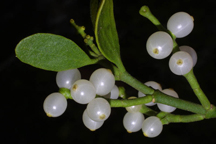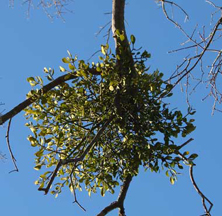Mistletoe
 We place Mistletoe on the Extra Day of the Year, or as som call it, the Nameless Day. It is the day after the Winter Solstice. The color of the Mistletoe is purple, its Class is Chieftain and is associated with healing and development on the spiritual level. This day is also known as the day of the "The Secret of the Unhewn Dolmen" and denoted the quality of potential in all things.
We place Mistletoe on the Extra Day of the Year, or as som call it, the Nameless Day. It is the day after the Winter Solstice. The color of the Mistletoe is purple, its Class is Chieftain and is associated with healing and development on the spiritual level. This day is also known as the day of the "The Secret of the Unhewn Dolmen" and denoted the quality of potential in all things.
 Mistletoe is one of the Druid's most sacred trees - as Ovid said, "Ad viscum Druidae cantare solebant. (The Druids are wont to sing to the Mistletoe.)." In Druidic lore Mistletoe is the special plant for the day after Yule. The Druids gathered their Mistletoe at Midsummer or at the 6th day of the moon. The Druid priests or priestesses would wear white robes while gathering the plant and would use a golden knife, taking extreme care not to let the plant touch the ground. Two oxen were often sacrificed for the harvest. The Druids considered that the Mistletoe that grew on Oak trees was the most potent and sacred. Mistletoe is a plant of the sun and also of the planet of Jupiter. It is associated with the element of the air. The colors of Mistletoe are green, gold and white.
Mistletoe is one of the Druid's most sacred trees - as Ovid said, "Ad viscum Druidae cantare solebant. (The Druids are wont to sing to the Mistletoe.)." In Druidic lore Mistletoe is the special plant for the day after Yule. The Druids gathered their Mistletoe at Midsummer or at the 6th day of the moon. The Druid priests or priestesses would wear white robes while gathering the plant and would use a golden knife, taking extreme care not to let the plant touch the ground. Two oxen were often sacrificed for the harvest. The Druids considered that the Mistletoe that grew on Oak trees was the most potent and sacred. Mistletoe is a plant of the sun and also of the planet of Jupiter. It is associated with the element of the air. The colors of Mistletoe are green, gold and white.

The gemstone associated with Mistletoe is Amber. In ancient times, amber was considered the most precious of the world's treasures, believed to be the gift of the God to the Goddess at the time of their first union.
Romans, Celtics, and Germans believed that mistletoe is the key to the supernatural. Mistletoe will aid and strengthen all magical works but is best called upon for healing, protection, and beautiful dreams - dreams which will unlock the secrets of immortality. Mistletoe is a good wood to use for making wands, other ritual tools and magical rings. The berries are used in love incenses, plus a few berries can be added to the ritual cup at a handfasting. Boughs of Mistletoe can be hung for all purpose protection around the house. Sprigs of Mistletoe can be carried as an herb of protection - plus amulets and jewelry can be made out of Mistletoe wood as protective talismans. Hung over the cradle, Mistletoe will protect the child from being stolen by the fey and Mistletoe that is carried will protect the bearer from werewolves. Mistletoe stood for sex and fertility - hence our tradition of kissing under the mistletoe. It is traditionally hung in the home at Yule, and those who walk under it exchange a kiss of peace. www.dutchie.org
Also known as the golden bough. Held sacred by both the Celtic Druids and the Norseman. Once called All Heal, used in folk medicine to cure many ills. North American Indians used it for toothache, measles and dog bites. Today the plant is still used medicinally, though only in skilled hands...it's a powerful plant.
It was also the plant of peace in Scandinavian antiquity. If enemies met by chance beneath it in a forest, they laid down their arms and maintained a truce until the next day.
Now for the kissing part…
Although many sources say that kissing under the mistletoe is a purely English custom, there's another, more charming explanation for its origin that extends back into Norse mythology. It's the story of a loving, if overprotective, mother.
The Norse god Balder was the best loved of all the gods. His mother was Frigga, goddess of love and beauty. She loved her son so much that she wanted to make sure no harm would come to him. So she went through the world, securing promises from everything that sprang from the four elements--fire, water, air, and earth--that they would not harm her beloved Balder.
Leave it to Loki, a sly, evil spirit, to find the loophole. The loophole was mistletoe. He made an arrow from its wood. To make the prank even nastier, he took the arrow to Hoder, Balder's brother, who was blind. Guiding Holder's hand, Loki directed the arrow at Balder's heart, and he fell dead.
Frigga's tears became the mistletoe's white berries. In the version of the story with a happy ending, Balder is restored to life, and Frigga is so grateful that she reverses the reputation of the offending plant--making it a symbol of love and promising to bestow a kiss upon anyone who passes under it. www.candlegrove.com
Botanical Properties of Mistletoe
There are two common mistletoes in Europe, both of which live as parasites on trees. The common mistletoe (Viscum album L.) parasitizes many tree species, including oaks in the western part of its range. It forms white berries between Samhain and Yule. The yellow-berried mistletoe (Loranthus europaeus L.) does not extend to western Europe. It is found primarily on oaks. It is most likely the "golden bough", being more common in the eastern Mediterranean than the common mistletoe. The common mistletoe has been cultivated in North American for the Yule trade, and there are several native mistletoes in the genus Phoradendron. Mistletoes are in the Mistletoe family (Viscaceae). www.cyberwitch.com